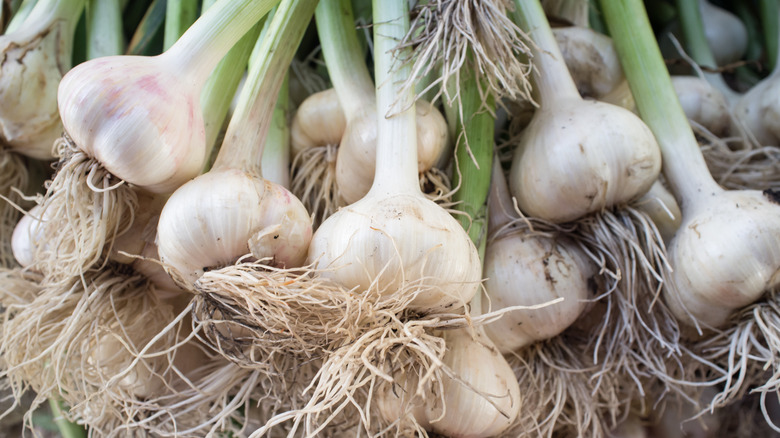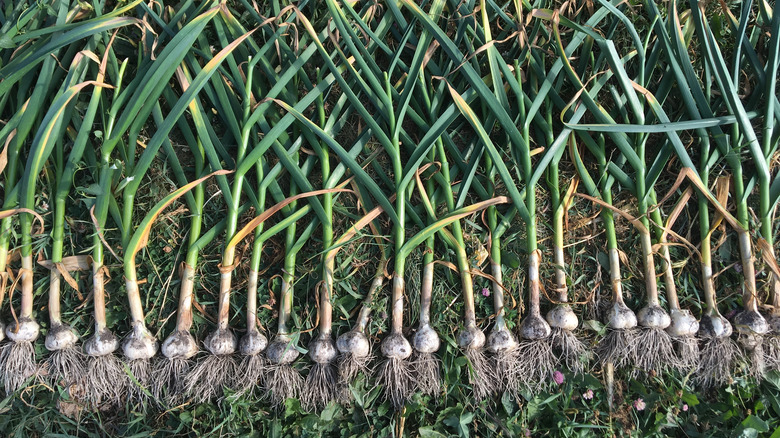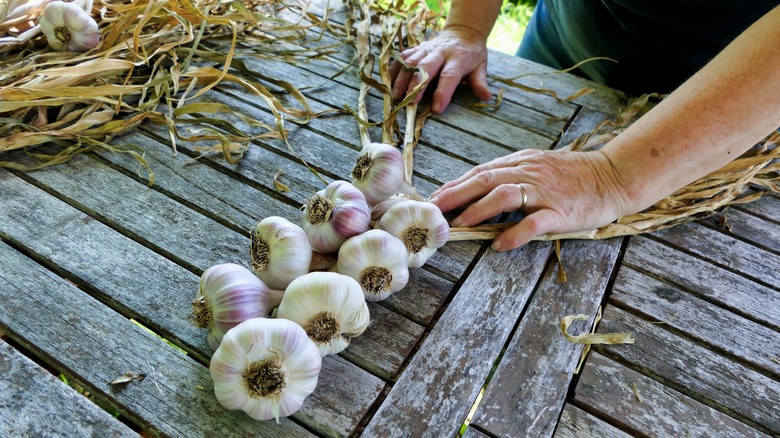How To Spot The Subtle Difference Between Hardneck And Softneck Garlic
Garlic, the most wonderful of foods, comes in more varieties than you might imagine if you simply buy the occasional head from the grocery store. For one thing, there are two general types of garlic: hardneck and softneck, with "neck" referring to the plant's stem. Hardneck garlic plants produce a tall (and delicious) flowering stem, while their softneck cousins sprout leaves. (So-called elephant garlic is a type of leek, so we shall speak no more of it, here.)
Since stems are usually removed before the garlic hits produce shelves, you can tell the difference between hardneck and softneck garlic in a couple of other ways, as well: By the number of cloves per bulb, and by the texture of the skin. Softneck garlic has a lot of smaller cloves per bulb (between eight and 20), while hardnecks might only manage a half dozen or so. Softneck garlic has a milder flavor and comparatively lengthy shelf life, so that's the kind you'll usually find in the store. But if you can get your mitts on the hardneck variety — say, at your local farmer's market — there's more to learn.
What is hardneck garlic?
Hardneck garlic's flowering stalk is also edible and considered a delicacy by many. This stalk is called a garlic scape, and they resemble big, curly chives. Store your scapes in the fridge (not on the countertop like garlic heads), and enjoy their less-intense garlic flavor either fresh (say, chopped up in a salad or as garnish for a scoop of hummus) or sautéed in olive oil along with other garden-fresh veggies for a vibrant side dish. You can also mix them into scrambled eggs or an omelet — use garlic scapes as you would scallion greens or chives.
Generally speaking, hardneck garlic cloves have a more robust, complex flavor than the softneck variety (though there's a simple way to tame that strong raw garlic taste). Its skin is thicker and more brittle, making peeling each relatively large clove much easier. You might also feel the hard protrusion of its remaining stem sticking out of the top of the bulb. In addition, you should know that hardneck garlic doesn't keep as long as softneck garlic. Even when stored correctly in a dark, well-ventilated place at temperatures between 50 and 60 degrees Fahrenheit, hardneck garlic won't last more than five months.
What is softneck garlic?
Softneck garlic produces a clove that is generally milder in both flavor and aroma than hardneck varieties, surrounded by papery skin. The bad news (as many of us know only too well) is that this can make for a protracted, sticky peeling process. The good news is that softneck garlic is perfect for braiding because its leaves stay supple even after harvesting — so, if you can buy a basketful of whole softnecks from the farmer's market, you'll know just what to do.
This is convenient, because softneck garlic stores beautifully: Under the same ideal storage conditions (dark, well-ventilated, and no warmer than 60 degrees Fahrenheit), softneck varieties will be perfectly edible up to a full year after harvest. No matter which kind of garlic you go for — zesty, pungent (and easy to peel!) hardnecks, or mild, braid-able softnecks — you'll be all set for making pesto, zesty salad dressing, (safely made and stored) fermented garlic honey, and roast garlic just the way you like it.


